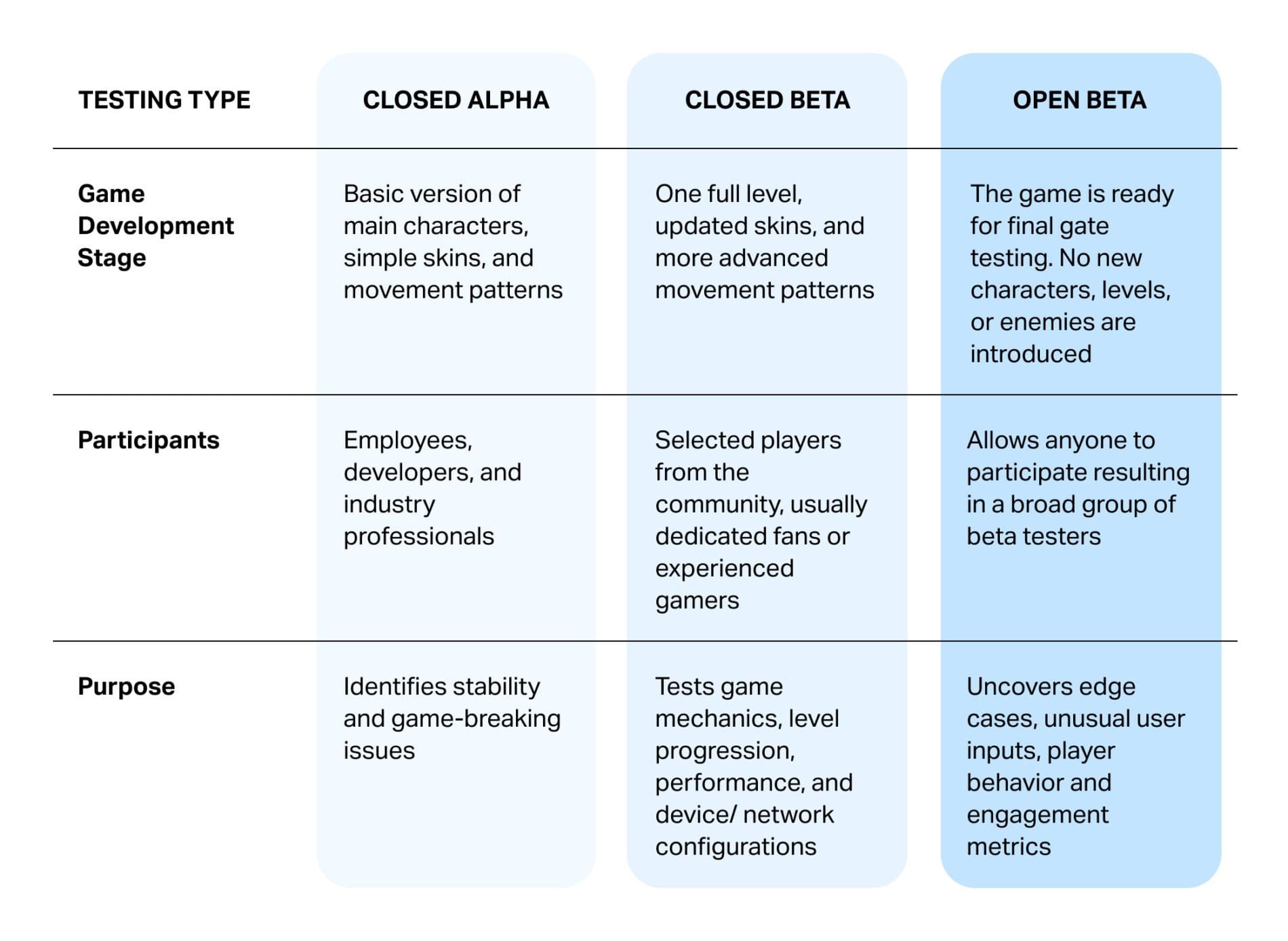A Guide to Crowdsourced Beta Testing for Video Games

In the video game development industry, releasing a well-polished and critically acclaimed title is crucial to success. However, even experienced development teams may face unexpected challenges in identifying and resolving issues before the official release. This is why beta testing is so important; it helps developers catch and fix any remaining problems before the game is released to the public.
What Is Beta Testing?
Beta testing allows developers to gather valuable feedback from a select group of players, helping them to refine and optimize their game before its official release. By releasing a semi-final version of the game, developers engage with gaming enthusiasts and casual gamers, who playtest the game, uncover hidden issues, and help shape the final product.
Through in-game forms, surveys, forums, and other communication channels, developers gather real-world data that helps to create a polished game that meets the needs and expectations of their audience.
Multiple beta versions can be released, each incorporating changes based on the feedback received. After addressing critical issues and making final adjustments based on beta tester feedback, the game undergoes final polishing and optimization before its official release.
Steam Early Access allows developers to release beta versions of highly anticipated games to thousands of customers so teams can identify and fix issues real users encounter before a public release.
Importance of Beta Testing in Game Development
Since beta testing is the final step before the official game release, it plays an important role in ensuring seamless and user-friendly releases. Let’s dive deeper into the importance of this testing phase:
1. Quality Assurance (QA)
During beta testing, developers gather feedback about any bugs that can negatively affect the gameplay experience. These could be anything from missing UI elements to major glitches. For example, if a close button is absent in a dialogue box, it might force players to restart the game or reload from a checkpoint.
Developers also collect feedback about the game’s performance across different hardware configurations, such as various CPUs, operating systems, monitor resolutions, and graphics cards.
2. User Experience Enhancement
Feedback collected from beta testing ensures improvements can be made to the game design and user interface. If game controls feel sluggish or unresponsive, developers can refine input handling to enhance control smoothness and responsiveness.
Additionally, feedback on gameplay elements like combat systems, puzzles, or resource management can identify areas that may feel imbalanced or lacking depth, leading to refinements that create a more engaging player experience.
3. Risk Mitigation
Launching a game with severe technical problems can result in refund requests, decreased sales, and potential financial losses. Beta testing helps identify and fix critical problems before the public release. For example, testers might report game crashes when entering specific areas or network issues during high player loads in multiplayer settings.
4. Market Validation
Beta testing acts as a form of market research, providing insights into the game’s appeal within its target audience. Feedback on player preferences for game genres, mechanics, themes, or specific features helps validate design decisions and identify popular elements, increasing the game’s market fit and appeal.
5. Building a Strong Community
Inviting players to participate in the beta testing process helps build a community of early adopters and dedicated fans. This community can become long-term advocates for the game, as seen in cases like the “Minecraft” beta phase, which attracted a devoted group of players who contributed to refining the game and promoting it post-release.
Different Stages of Beta Testing
Beta testing often involves three phases: closed alpha, closed beta, and open beta.
1. Closed Alpha
The closed alpha stage is highly controlled and features a basic version of the main characters, represented by simple skins that can move around the screen and collide with the basic shapes of platforms. Testers often include carefully selected internal employees, developers, and industry professionals.
This stage identifies critical issues, such as game-breaking bugs. It ensures the absence of problems like missing close buttons in dialogues that could prevent players from progressing through the storyline. Testers also verify that character movements feel right and that the character cannot pass through collisions or other characters.
2. Closed Beta
In closed beta, developers test a full level with updated character skins and movement abilities with a larger group of beta testers. Hundreds or even thousands of selected players provide feedback on gameplay mechanics, pacing, and experience, helping developers fine-tune difficulty curves, progression systems, and rewards.
Testers also provide feedback on performance across various hardware configurations, frame rate, loading times, and network latency. Dedicated forums, feedback channels, and direct communication between developers and testers facilitate community building and engagement.
3. Open (or Public) Beta
During the open beta stage, the game is almost complete. All levels are finished, and there are no major characters or enemies introduced. All issues in previous stages must be resolved before a public beta.
The open beta allows anyone interested to participate, potentially reaching thousands or even millions of players. This large-scale testing helps uncover many issues, bugs, and edge cases that may have been missed in previous phases.
The game developers collect extensive data on player behavior, progression, and engagement metrics, enabling them to make data-driven adjustments and optimize the game’s overall gameplay and performance.

Challenges with In-House Beta Testing Management
1. Limited Tester Diversity
Using only in-house QA testers can limit the range of testing and exclude diverse preferences, skills, environments, and demographics. Highly competitive testers may easily complete difficult levels that could easily frustrate more casual, less competitive players. External perspectives are crucial for successful public launches and game localizations due to cultural differences in player perceptions and interactions.
2. Resource Constraints
In-house beta testing programs require significant investment in time, personnel, and finances. Some of the additional expenses include hiring, managing, and coordinating dedicated testing teams and providing testers with hardware.
As the testing program scales up, it requires more oversight from producers and leads, diverting their time from other critical development tasks. Additionally, analyzing and integrating large amounts of testing data and feedback is also time-consuming.
3. Bias and Familiarity
In-house testers can become too close to a project, leading to unintentional bias and blind spots. Familiarity can cause testers to overlook issues, such as confusing UI, controls, tutorials or subtle visual bugs. It is essential to have fresh eyes on the project to surface this type of feedback.
4. Inflexible Scalability
Scaling your team for testing and development can be slow and expensive. It takes time and resources to onboard and train new team members to handle the complexities of beta testing.
5. Feedback Echo Chamber
In-house testers may become too familiar with a game during development and testing, limiting their scope. This creates an echo chamber where significant issues don’t surface. Fresh, unbiased perspectives from external players are critical to break out of these internal feedback loops.
The Role of Crowdsourced Beta Testing
Crowdsourced beta testing involves a diverse group of testers providing feedback on a product. Developers release their products to a wide range of testers using different devices and operating systems to identify issues that an in-house team might not find.
Additionally, crowdsourcing allows developers to test game mechanics in real-world conditions, where users introduce unexpected inputs that can’t be tested in a simulated environment. This approach accelerates beta testing and reduces costs compared to traditional in-house methods.
Crowdsourcing vendors like Testlio streamline the beta testing workflow by recruiting beta testers, managing the testing process, collecting feedback, and analyzing results. This allows the in-house QA teams to concentrate on essential development tasks, facilitating faster release cycles.

